Past Year Questions: Beams | Topic wise GATE Past Year Papers for Civil Engineering - Civil Engineering (CE) PDF Download
Q1: Consider the horizontal axis passing through the centroid of the steel beam cross-section shown in the figure. What is the shape factor (rounded off to one decimal place) for the cross-section? [GATE CE 2023 SET-1]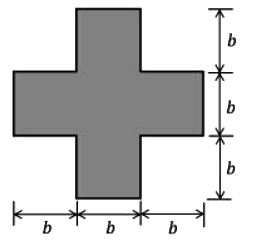 (a) 1.5
(a) 1.5
(b) 1.7
(c) 1.3
(d) 2
Ans: (b)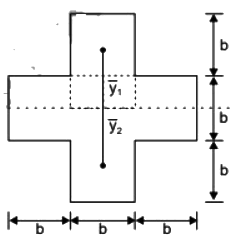


= (11/4) b3
ze = (29/18)b3
Shape factor (S) = 
Q1: The flange and web plates of the doubly symmetric built-up section are connected by continuous 10 mm thick fillet welds as shown in the figure (not drawn to the scale). The moment of inertia of the section about its principal axis X-X is 7.73 × 106 mm4. The permissible shear stress in the fillet welds is 100 N/mm2. The design shear strength of the section is governed by the capacity of the fillet welds.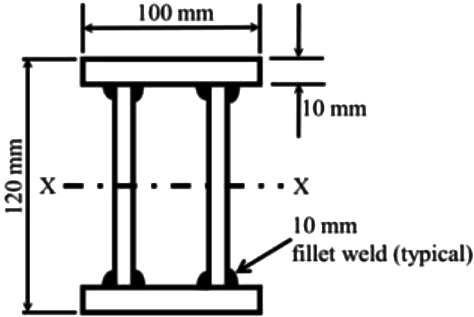 The maximum shear force (in kN, round off to one decimal place) that can be carried by the section, is _______. [GATE CE 2020 SET-1]
The maximum shear force (in kN, round off to one decimal place) that can be carried by the section, is _______. [GATE CE 2020 SET-1]
Ans: 393.5 to 399.1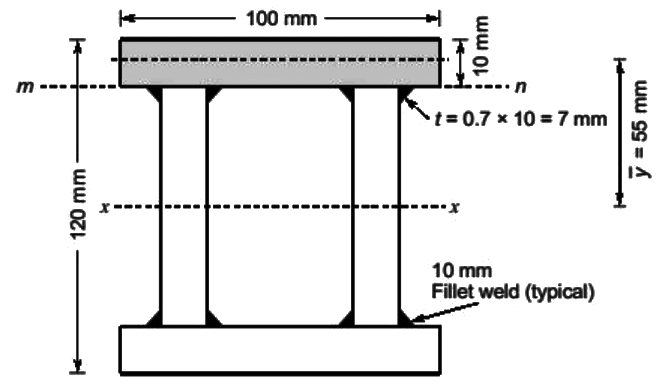 q = Shear stress at the level mn in the weld = 100 MPa =
q = Shear stress at the level mn in the weld = 100 MPa = 
Shear force at the given section
A = Area of the cross-section above the level mn = 100 × 10mm2 = C.G. of shaded area above the level mn = 60 - 5 = 55 m
= C.G. of shaded area above the level mn = 60 - 5 = 55 m
I = 7.73 × 106 mm4
b = Width of weld at mn (4 welds) = 4 x t = 4 x 7 = 28 mm
t = Throat thickness
= 0.7 × s = 0.7 × 10 × 4 = 28mm
= 393.527 kN
Q1: A rolled I-section beam is supported on a 75 mm wide bearing plate as shown in the figure. Thicknesses of flange and web of the I-section are 20 mm and 8 mm, respectively. Root radius of the I-section is 10 mm. Assume: material yield stress, fy = 250 MPa and partial safety factor for material. γmo = 1.10.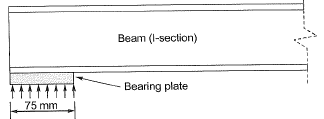
As per IS: 800-2007, the web bearing strengt (in kN, round off to 2 decimal places) of the beam is_____. [2019 : 2 Marks, Set-II]
Ans: Web bearing strength

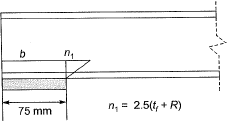

Q2: Assuming that there is no possibility of shear buckling in the web, the maximum reduction permitted by IS 800-2007 in the (low-shear) design bending strength of a semi-compact steel section due to high shear is [2019 : 1 Mark, Set-I]
(a) Zero
(b) governed by the area of the flange
(c) 50%
(d) 25%
Ans: (a)
As per IS 800 : 2007
For semi compact section

So reduction is zero.
Q1: A steel column of ISHB 350 @ 72.4 kg/m is subjected to a factored axial compressive load of 2000 kN. The load is transferred to a concrete pedestal of grade M20 through a square base plate. Consider bearing of concrete as 0.45 fck, where fck is the characteristic strength of concrete. Using limit state method and neglecting the self weight of base plate and steel column, the length of a side of the base plate to be provided is [2018 : 1 Mark, Set-I]
(a) 39 cm
(b) 42 cm
(c) 45 cm
(d) 48 cm
Ans: (b)
Area required for base plate

= 48.24 mm
= 40.8 cm
Since, provided area must be more than required so answer should be 42 cm.
Q1: The semi-compact section of a laterally unsupported steel beam has an elastic section modulus, plastic section modulus and design bending compressive stress of 500 cm3, 650 cm3 and 200 MPa respectively. The design flexural capacity (expressed in kNm) of the section is______. [2016 : 1 Mark, Set-I]
Ans: Design flexural capacity,
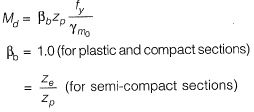
zp = plastic section modulus
ze = elastic section modulus
fy = yeild stress of steel provided
γm0 = material factor of safety of steel against yeilding
As, design bending stress is directly given,


Q1: A steel section is subjected to a combination of shear and bending actions. The applied shear force is V'and the shear capacity of the section is Vs. For such a section, high shear force (as per IS 800 : 2007) is defined as [2014 : 1 Mark, Set-I]
(a) V>0.6 Vs
(b) V>0.7 VS
(c) V > 0.8 Vs
(d) V > 0.9 Vs
Ans: (a)
According to IS 800 : 2007, clause 9.2.1 No reduction in moment capacity of the section is necessary as long as the cross-section is not subjected to high shear force (factored value of shear force in less than or equal to 60 percent of the shear strength of the section)
Q1: The adjoining figure shows a schematic representation of a steel plate girder to be used as a simply supported beam with a concentrated load. For stiffeners, PQ (running along the beam axis) and RS(running between the top and bottom flanges) which of the following pairs of statements will be TRUE? [2011 : 2 Marks]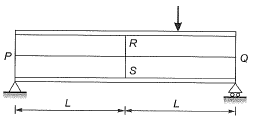
(a) (i) RS should be provided under the concentrated load only
(ii) PQ should be placed in the tension side of the flange.
(b) (i) RS helps to prevent local buckling of the web.
(ii) PQ should be placed in the compression side of the flange.
(c) (i) RS should be provided at supports.
(ii) PQ should be placed along the neutral axis
(d) (i) RS should be provided away from points of action of concentrated loads.
(ii) PQ should be provided on the compression side of the flange.
Ans: (b)
PQ is a horizontal stiffener in the given plate girder. Horizontal stiffeners are also called longitudinal stiffeners. The horizontal stiffener are provided in the compression zone of the web. The first horizontal stiffener is provided at one-fifth of the distance from the compression flange to the tension flange. If required another stiffener is provided at the neutral axis. Horizontal stiffeners are not continuous and are provided between vertical stiffeners.
RS is a vertical stiffener in the given plate girder. Vertical stiffeners are also called transverse stiffeners. It is assumed that the vertical stiffener is not subjected to any load and is selected to provide necessary lateral stiffness only and can there fore , be crimped or joggled for tight fittings . Such stiffeners increase the buckling resistance of the web caused by shear.
FAQs on Past Year Questions: Beams - Topic wise GATE Past Year Papers for Civil Engineering - Civil Engineering (CE)
| 1. What are the different types of beams used in structural engineering? |  |
| 2. How do you calculate the bending moment and shear force in a beam? |  |
| 3. What factors affect the deflection of a beam? |  |
| 4. What is the significance of the moment of inertia in beam design? |  |
| 5. What are the common failure modes of beams under load? |  |





















